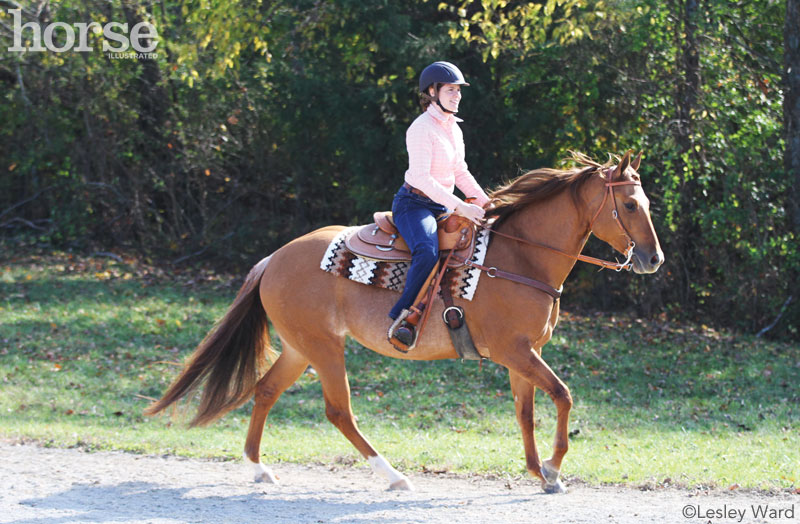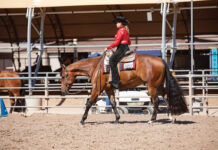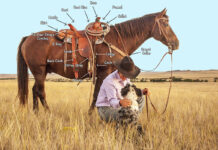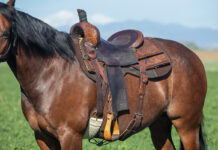Cueing your horse to canter (or lope, whichever term you prefer) can cause a bit of tension, especially if your horse has a history of kicking out, bucking or refusing to move forward.

Why Does My Horse Buck at the Canter?
If your horse is bucking or simply refuses when you cue for the canter, it’s important to rule out physical pain or discomfort before correcting the horse. Have a veterinarian check out your horse and ask a pro to check saddle fit.
Is your horse raising his head or fighting you in the transition? Ask a friend or instructor watch you to make sure that you’re not accidentally pulling on the reins at the same time you’re asking for the canter. If your horse feels a tug as soon as he takes the first big canter stride, he might get confused.
The Lope Cue
Plan ahead to make sure that you pick the perfect spot in the arena for your transition. Ask for the canter just after a turn to the long side of the arena, so you have ample space to move forward. Make your cue soft and relaxed and only use the pressure necessary to boost your horse into the canter. Take a few big breaths to help you relax and sit deeply in the saddle. Then apply these aids in order and in slow motion:
- Slide your outside leg back and apply pressure to your horse’s side.
- Lift your inside hand slightly.
- Push lightly forward with your seat, moving in the canter motion. At the same time, many people also like to make a kissing sound or say “canter” for a verbal cue.
Throughout the process, leave the reins loose. Continue at the canter until the horse relaxes and moves ahead without your constant pushing. Only stop when your horse is cantering well—and the decision to slow down is yours.
Troubleshooting the Canter Cue
A horse that refuses to move into the canter or a horse that bucks needs to be pushed to move forward.
Often, riders who have a problem with the canter transition stop to regroup. That pause, no matter how short, is a reward for your horse.
Only use the pressure necessary to move the horse forward. If your horse throws a “temper tantrum” (buck or kick), ignore it and calmly and confidently ask him to move forward. He must work harder, to show him that his bucking fit wasn’t the right answer.
Move your hands forward toward his ears to show him that forward is the correct direction and add leg pressure gradually until he moves on.
Once you feel your horse’s back relax, allow him to slow down to a slower canter before resting.
If your forward cues cause your horse to trot faster and faster, it’s time for greater reinforcement. Reprimanding him verbally may do the trick.
Still no canter? With an instructor’s help, you may need to learn to tap your horse with the reins or carry a crop. Keep in mind that crops aren’t meant to cause pain or to be mean.
Tapping a horse once on the shoulder to correct his disobedience is much better than continually kicking him when he won’t move on to the canter. One kind-but-firm correction may be all that’s ever needed to remind a well-trained horse that he is to move at the speed requested until another cue is given.
Remember, most horses want to be good. Praise your horse when he correctly steps into the canter and you will be a pro at your transitions in no time!
This article originally appeared in the November/December 2017 issue of Young Rider magazine. Click here to subscribe!






How do you apply this method if your horse is deaf